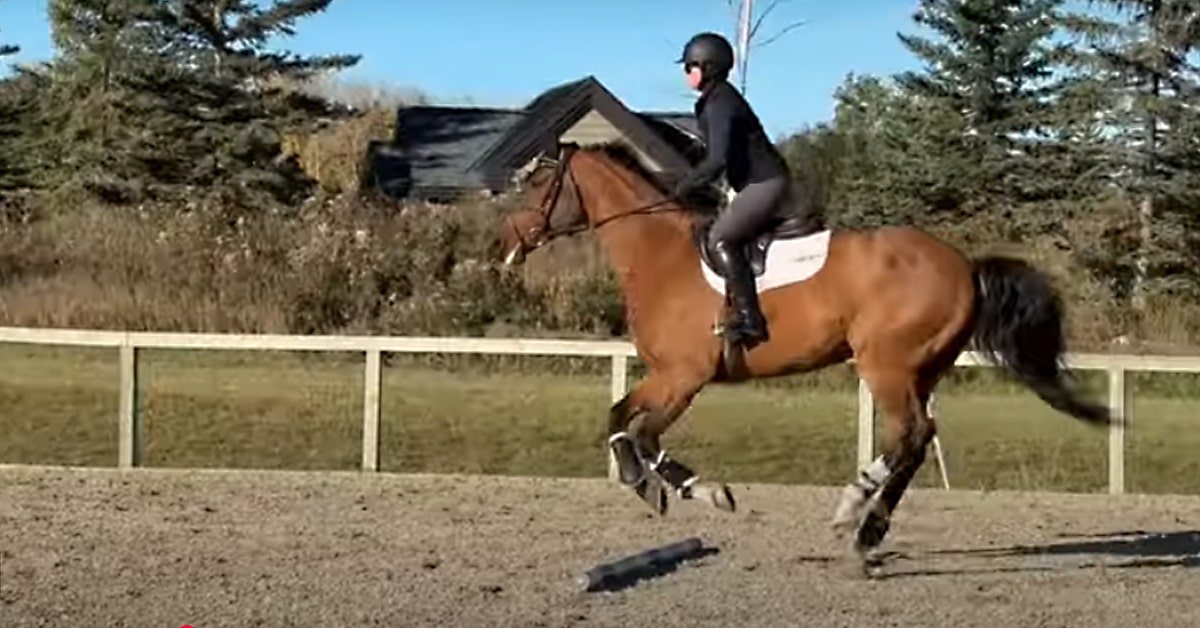Hills offer indisputable conditioning potential, but their benefits rely on approaching them with a plan that is relevant to a goal. In the case of building strength, there is no guarantee of results by making your horse occasionally climb inclines that leave him winded and sweaty. When using terrain to strengthen locomotive muscles, slope angles and repeatability of efforts, plus strategic rest intervals, play an enormous role.

Take heart if you lack access to steep hills. Aside from very specific conditioning goals, steep climbs are generally not used for strength workouts targeting basic strength gains. Also, rest assured that you do not need access to miles of hilly terrain. In fact, many of the following workouts prefer mild slopes that allow for repeatable dosages. An ideal slope angle will require the horse to change his center of gravity, flex his joints more, and engage his topline and bottom-line muscle chains with greater force. Most pastures have a swale or rise that fits this description.
For the purposes of clarity and prescription, the workouts in this chapter use the following profiles.
Mild Slope—A gentle uprising that progressively gains height; terrain gains 6 to 8 vertical feet over 100-foot distance. Many driveways and pastures fit the description.
Moderate Slope—This requires more effort; the horse needs to use shorter, more powerful strides to ascend. Heart and respiratory rate will increase notably after a few hundred feet. Terrain gains 8 to 10 vertical feet over 100-foot distance.
Steep Slope—A type of hill that requires automobiles to downshift to lower gears; terrain gains 15 to 20 vertical feet over 100-foot distance.

Mild slope (A), moderate slope (B), and steep slope (C).
If you lack access to slopes that fit these exact profiles, perhaps you have at least a gentle upswell, berm, or ditch. The longer uphill reps cannot be performed in this case, but the workouts that call for maneuvering around and across a mild slope certainly can.
Modifications
In-Hand
Several of the workouts in the pages ahead could be adapted to perform in-hand if that works better for your terrain and your horse’s current level of training or fitness. When modifying for this purpose, be sure to keep the horse’s neck aligned straight in front of his body rather than curved toward you. The horse’s body needs to be aligned when training on slopes or there is the possibility of strengthening asymmetrical movement, rather than achieving the fitness goals you want.
Rehab Cases
Many of these hill workouts can also be modified to serve horses in physical rehab. By adjusting reps and overall duration, they offer good settings for reawakening neuromotor activity, proprioception, and body control. Work with a vet or sports therapist to modify the routines to fit within a prescribed rehab plan.
Senior Horses
Owners of senior horses often wonder if or when they should stop riding hills. My advice is to really listen to your own individual horse. First, no unfit senior should be ridden up and down hills. Without fitness, the effort of hills brings a lot of strain and the possibility for negative forces on joints. Especially in the case of arthritis, a horse should have at least a little fitness before enjoying hilly rides. When fitness exists, hills are not necessarily an uncomfortable experience for an older or arthritic horse. My general rule is to let each horse tell you. Most horses will get to a point where they can no longer ride hills, but this might be a lot later than you expect. Do not preemptively decide your horse is too old to ride on hills until he or she has given you very clear reasons. If you treat horses like they are “old” by limiting activities based on their numeric age, they will become old. If, on the other hand, you read their bodies and attitudes and fitness levels, as opposed to their years, they might not “act their age” until past a surprising point.
The signs I look for to determine if hills should be avoided with an older horse are consistent expressions of discomfort or struggle. This includes a persistent unwillingness to travel down hills straight (that is, the horse always wants to shift his hindquarters to one side), an inability to maintain steady rhythm down hills, excessive tripping and stumbling, an abnormally high heart rate on moderate slopes, and repeated balkiness. When these kinds of signs show up repeatedly, it might be a good time to avoid hills and to make fitness gains with other routines. Or it might be time to seek out different gradients. Even if your horse can no longer ride steep slopes, it does not mean that mild ones are out of the question.
Rider’s Role
A general rule of thumb when riding slopes is to keep your own body parallel with nearby trees. This will mean a slight incline or recline of the torso, depending on the angle of your slope. This is not an exaggerated lean; it will hinder the horse to move your weight far ahead or behind his center of gravity near the withers.
Also pay attention to the position of your lower leg. It is common, when riding with long stirrups, for the lower leg to swing forward near the horse’s shoulders when descending hills. This is disadvantageous to the horse as it causes the rider’s seat to sink more heavily into the back of the saddle. Adding pressure or tension here impedes the ability of the horse’s hind legs to step freely forward under the horse’s body. Similarly, when riding up hills, riders who lean too far forward inadvertently swing their lower legs back toward the horse’s flanks. As a result, these riders tip more weight toward the front of the saddle, sometimes clenching with their knees, and end up ahead of the horse’s center of gravity. Our goal when riding hills should be to remain as balanced in the saddle as possible without an exaggerated lean either forward or backward. We also want to keep our heels below our hips rather than displacing our legs forward or backward. Hills are hard enough for horses; we do not want to add burden by requiring the horse to find balance under our own misaligned bodies.
Horse Form
As with most training exercises, the horse will benefit most from being in good balance and posture on hills. This does not mean he should look like an advanced dressage competitor, but we also do not want him lollygagging around with a hollow topline or his neck twisted to one side or hanging down to the ground. An ideal posture allows the horse to bear weight equally over all four legs and to shift weight easily from front end to hind end, and vice versa. For most horses, this is a posture where the topline is horizontal to the ground, with poll and withers and sacrum nearly level. This is sometimes referred to as a natural balance, or one that resembles an elongated, gently arched rainbow.
Adapt to Your Terrain
Many of the following workouts ask you to travel up and down the same slope. Depending on your situation, this might not be possible. Your hill might be too narrow to turn around on or perhaps your footing might get slippery with repetitive travel. Or maybe your horse gets antsy and unsettled by repeating the same terrain up and down. It might suit you better to plan these workouts somewhere that allows you access to a sequence of hills nearby rather than trekking up and down the same one. If this is the best option, do it even if it means your interval durations might not match the workout assignment. It is far better to modify the workout slightly to fit your situation than to skip it. The same applies to the steepness of your terrain. If a workout asks for a moderate slope but you only have a mild one, just go ahead and use what you have. There is still value in the structure, timelines, and tasks given in each workout even if your available terrain does not entirely match the description. So go ahead, get creative, and get out there.
Hillside Freestyle
DURATION: Approximately 35 minutes
SLOPE: Mild to moderate
BENEFITS: There is not a “right” or “wrong” way to execute the following exercise circuit, meaning you can arrange exercises in any order. The point is to give the horse a constant need to adapt and organize his body to the changing balance and slope angle. You will be traversing up, down, across, and around the slope to continuously change the horse’s effort.

1. For 15 minutes: Warm up with walk and easy trot on flat ground, either riding
or longeing. Then proceed to the slope.
2. For 15 minutes: Perform a repeating circuit of the following tasks without pauses:
• Serpentine up and down the slope.
• Walk sideways across the slope face.
• Lengthen and shorten strides while walking up and down the slope.
• Perform small and large circles on the slope face.
• Transition between gaits.
3. Finish with 5 minutes of brisk walking on flat ground.
TIP: For this workout, choose the gaits—or combination of them—that suits your horse’s current ability. The exercise works for walk, jog, a bit of slow canter, or a smattering of all.
Power Surges
DURATION: Approximately 40 minutes
SLOPE: Moderate to Steep
BENEFITS: Combining speed and resistance, short uphill surges can recruit fast-twitch muscle fibers. This benefits activities that require moments of explosive strength, such as high-level collection, accelerations, sprints, and riding fast obstacles. It also contributes to metabolic efficiency, allowing the athlete to shift between different muscle functions and energy pathways.
HOW-TO:
1. For 15 minutes: Do an energetic warm-up.
2. For 10 seconds: Gallop uphill, going “all-out.”
3. For 45 seconds: Walk downhill at a calm, easy pace.
4. Repeat Steps 2 and 3 a total of 10 times.
5. For 3 minutes: Rest at walk or easy jog, ideally on flat ground.
6. Repeat Steps 2 and 3 for 3 more times.
7. Finish with easy riding on flat ground for 10 minutes.
TIP: Due to the repetitive format, some horses might begin getting squirmy through anticipation on the downhill walk rests. Be sure to keep them straight and aligned through their bodies, even if that means getting their minds to settle and slow down by adding a few halt transitions. Alignment is key during strength sessions!
***
Order your copy of 33 Strength and Fitness Workouts for Horses from Trafalgar Square Books here.
The Latest









